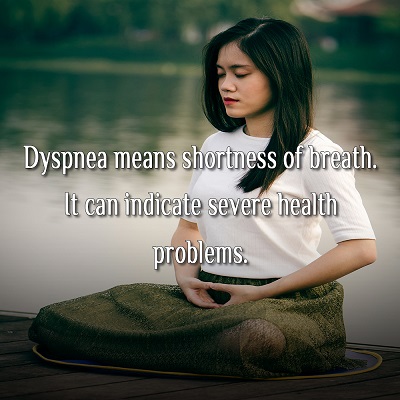 While countless love songs and ballads have romanticized the term “take my breath away,” medically speaking, dyspnea is a serious matter. Dyspnea, more commonly referred to as shortness of breath, can be a sign of an underlying medical condition that needs to be treated. Experiencing dyspnea often from doing simple physical activities can also be an indication of poor health.
While countless love songs and ballads have romanticized the term “take my breath away,” medically speaking, dyspnea is a serious matter. Dyspnea, more commonly referred to as shortness of breath, can be a sign of an underlying medical condition that needs to be treated. Experiencing dyspnea often from doing simple physical activities can also be an indication of poor health.
Causes of Dyspnea
The common cause of dyspnea is overexertion. When we perform heavy physical activities such as running or swimming, experiencing shortness of breath is normal. But healthy individuals will be able to recover from dyspnea after just a few minutes.
Underlying medical conditions can also be a cause of dyspnea. Patients with heart problems and low blood pressure are more likely to experience frequent bouts of dyspnea. Similarly, people suffering from respiratory illnesses and chronic obstructive pulmonary diseases such as asthma, emphysema, bronchitis, pneumonia, and pulmonary embolism are also more susceptible to dyspnea.
Other causes relating to a person’s overall physical health, such as smoking and obesity, are also linked to dyspnea. People who are experiencing stress and anxiety can also feel a shortness of breath.
External factors are also possible causes of dyspnea. Being at a high altitude, where there is less oxygen, can lead to dyspnea, especially if the person is not used to experiencing low levels of oxygen. Dyspnea can also be a consequence of carbon monoxide poisoning.
Symptoms of Dyspnea
People who are generally healthy may experience mild and temporary symptoms of dyspnea. However, patients with heart and lung problems can experience feeling suffocated and labored, shallow, and rapid breathing, as well as feeling tightness in the chest. Wheezing, palpitations, and intense coughing can also be experienced as a result of the patient’s underlying medical condition.
When to Seek Medical Advice
Since dyspnea is often linked to underlying conditions, seeking medical is advice is recommended when the patient experiences shortness of breath frequently in order to further understand the real cause behind their dyspnea. Another indication the patient should see a doctor is when they experience dyspnea while doing activities that didn’t cause shortness of breath in the past. Similarly, if the patient experiences a sudden onset of dyspnea without any obvious triggers, then it is best to check with a doctor.
Emergency treatment is necessary if the patient has a fever, chills, cough, or wheezing along with dyspnea. The same goes for swelling of feet and ankles and having difficulty breathing when lying down, as well as lightheadedness and chest pain.
Treatment
Treating dyspnea also means treating its underlying cause. Pulmonary and cardiac rehabilitation will be needed for those whose dyspnea is caused by cardiac or respiratory issues. Patients may be advised to use a portable tank to manage dyspnea. Breathing exercises and techniques can also be beneficial.
If the cause of dyspnea is an unhealthy lifestyle, then starting a healthy diet and exercising regularly are recommended to reduce instances of dyspnea. Quitting smoking is also a very good way to lessen bouts of dyspnea.
Dyspnea and COVID-19
With the onset of COVID-19, people have become much more aware of their respiratory health. The World Health Organization has already identified dyspnea as one possible symptom of the virus in severe cases. Doctors believe that dyspnea could be a sign that the lungs are already inflamed. When this happens, pneumonia can develop and dyspnea can worsen.
In relation to COVID-19, dyspnea is not a specific symptom, meaning patients who are experiencing dyspnea only and not other symptoms related to COVID-19 may not necessarily be infected with the virus. It possible that dyspnea can be present because of anxiety.
Observe for other symptoms first before contacting a medical professional. But if you are still concerned about the existence of dyspnea because of the virus, and if you have other symptoms that could be related to COVID-19, you can check with your doctor to see if you are qualified to take a COVID-19 test.
Frequent dyspnea is more than just experiencing breathlessness. It may point to other more serious conditions that need to be diagnosed and treated properly. It can also be an indication that you need to practice a healthier lifestyle, such as dieting, exercising, or quitting smoking. Either way, dyspnea can be our body’s way of telling us to pay more attention to our health.






